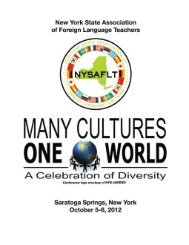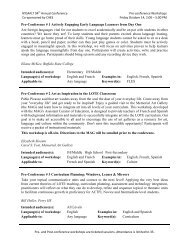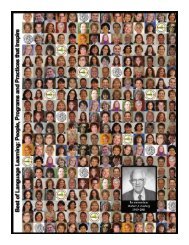NASBE<strong>THE</strong> <strong>COMPLETE</strong> <strong>CURRICULUM</strong>Chapter 3The Narrowing of <strong>the</strong>CurriculumThis chapter examines <strong>the</strong> state ofarts <strong>and</strong> <strong>for</strong>eign language education in<strong>the</strong> country today. While <strong>the</strong> actualpicture of <strong>the</strong> study of arts <strong>and</strong> <strong>for</strong>eignlanguages is mixed, <strong>the</strong> Study Group isconcerned that <strong>the</strong> trend is movingtoward a more narrowed curriculum—one that does not include an adequateamount of instruction in <strong>the</strong> arts <strong>and</strong><strong>for</strong>eign languages as a part of <strong>the</strong> corecurriculum.The good news is that <strong>the</strong>number of credits earned by highschool students in <strong>the</strong> arts <strong>and</strong> <strong>for</strong>eignlanguages has been rising <strong>for</strong> 20 years.However, <strong>the</strong>re is bad news in severalareas. First, <strong>the</strong>re is a problem wi<strong>the</strong>quity. Students who attend wealthy,high-per<strong>for</strong>ming schools often havemany more opportunities to study <strong>the</strong>arts <strong>and</strong> <strong>for</strong>eign languages than studentsat low-per<strong>for</strong>ming schools or schoolsthat serve low-income students.Second, <strong>the</strong>re is a large gap inpolicies surrounding <strong>the</strong> arts <strong>and</strong><strong>for</strong>eign languages. While most stateshave st<strong>and</strong>ards in <strong>the</strong>se subjects <strong>for</strong>what students should know <strong>and</strong> beable to do, <strong>the</strong> arts <strong>and</strong> <strong>for</strong>eignlanguages are generally absent frompolicies that hold districts <strong>and</strong> schoolsaccountable <strong>for</strong> student learning. Inresponse, when educators <strong>and</strong>administrators allocate resources,schedule classes, <strong>and</strong> implementprograms, <strong>the</strong> arts <strong>and</strong> <strong>for</strong>eignlanguages are often given short shrift.The State of <strong>the</strong> <strong>Arts</strong><strong>Arts</strong> education has receivedincreased attention in recent years,due in large part to promotionalef<strong>for</strong>ts in <strong>the</strong> national arena, as well asrecent research citing increasedacademic, personal <strong>and</strong> social successas a result of engaging in <strong>the</strong> arts.This renewed emphasis on artseducation came after a period ofneglect during <strong>the</strong> 1980s <strong>and</strong> early1990s when <strong>the</strong> arts were oftenslighted as school budgets grew tight<strong>and</strong> as educational priorities shifted to<strong>the</strong> basic subjects, such as reading,ma<strong>the</strong>matics, <strong>and</strong> science. The trendcame to a head in 1989; <strong>the</strong> NationalEducation Goals were crafted at <strong>the</strong>historic summit in Charlottesville—with no mention of <strong>the</strong> arts.However, work had alreadybegun to reverse this trend. In 1988,<strong>the</strong> National Endowment <strong>for</strong> <strong>the</strong> <strong>Arts</strong>published Toward Civilization, whichargued that <strong>the</strong> state of arts educationin American schools was in distress<strong>and</strong> offered recommendations <strong>for</strong>improvement. This was followed by awave of artistic activism <strong>and</strong> researchstudies into <strong>the</strong> benefits of artseducation. In 1991, <strong>the</strong> NationalAssessment Governing Boardapproved <strong>the</strong> inclusion of <strong>the</strong> arts in<strong>the</strong> 1997 National Assessment ofEducational Progress (NAEP). Threeyears later in 1994, Congress passed<strong>and</strong> President Clinton signed <strong>the</strong>Goals 2000 Act, which added <strong>the</strong> artsto <strong>the</strong> National Education Goals, <strong>and</strong><strong>the</strong> National <strong>Arts</strong> Education St<strong>and</strong>ardswere released. During this time,a series of federal initiatives werelaunched to create sample assessmentframeworks, encourage arts education10
<strong>Ensuring</strong> a <strong>Place</strong> <strong>for</strong> <strong>the</strong> <strong>Arts</strong> <strong>and</strong> Foreign Languages in America’s Schoolsresearch, <strong>and</strong> convene nationalmeetings to promote arts education.As detailed in Chapter 2, <strong>the</strong> resultsof <strong>the</strong>se research studies confirmed<strong>the</strong> advantages of student participationin arts education.Results from a 1999-2000 FastResponse Survey System (FRSS) on<strong>the</strong> status of arts education found thatmusic <strong>and</strong> visual arts instruction wereavailable in nearly all of <strong>the</strong> publicelementary schools across <strong>the</strong>country. 13 In high schools, roughly<strong>the</strong> same percent of schools offeredmusic <strong>and</strong> visual arts (90 <strong>and</strong> 93percent, respectively). However, onlyone-fifth of elementary schools <strong>and</strong> 14percent of secondary schools offereddance. Drama was available <strong>for</strong> 20percent of elementary school students<strong>and</strong> just under half of high schoolstudents. It should also be noted thatwhile art <strong>and</strong> music were available in<strong>the</strong> majority of schools, <strong>the</strong> number ofschools that offered <strong>the</strong>m with fulltimespecialists was markedly lower.The FRSS study also found thatschools offering courses in <strong>the</strong> artsdid not vary greatly when takinginto account race or income.However, a gap did exist whenexamining issues such as dedicatedspace <strong>for</strong> arts instruction, as well ascurriculum resources in elementarysettings. For secondary schools,those with lower concentrations ofminority or high-poverty studentswere also more likely to receiveoutside funding <strong>and</strong> to employ agreater number of specialists, thuscreating more opportunities <strong>for</strong> artsactivities.The development of a national test<strong>for</strong> arts education was ano<strong>the</strong>rimportant step <strong>for</strong> <strong>the</strong> field. In 1997,<strong>the</strong> National Assessment of EducationalProgress (NAEP) arts assessmentwas administered to 6,500 eighthgradestudents nationwide who hadreceived any arts instruction during<strong>the</strong>ir school careers (a process whichrevealed, among o<strong>the</strong>r things, thatonly half of eighth grade studentsacross <strong>the</strong> country had received anyarts instruction). The NAEP testmeasured students’ knowledge <strong>and</strong>skills in music, <strong>the</strong>atre, <strong>and</strong> visual arts—an important breakthrough in <strong>the</strong>development of assessments across art<strong>for</strong>ms. The results fur<strong>the</strong>r highlightedano<strong>the</strong>r alarming trend of <strong>the</strong>marginalization of <strong>the</strong> arts in <strong>the</strong>curriculum.The framework <strong>for</strong> <strong>the</strong> assessmentemphasized creating <strong>and</strong>per<strong>for</strong>ming works of art, <strong>and</strong> studying<strong>and</strong> analyzing existing works. Tocapture <strong>the</strong>se elements, <strong>the</strong> artsassessment focused on exercises thattested au<strong>the</strong>ntic tasks, such as singingor dancing, <strong>and</strong> constructed-response<strong>and</strong> multiple-choice questions, whichgauged <strong>the</strong> students’ abilities toevaluate works of art in written <strong>for</strong>m.The results varied by discipline,but tended to be higher when gauginga student’s ability to evaluate a pieceof art versus creating or per<strong>for</strong>ming.14 For example, <strong>for</strong> visual arts 55percent of students could identifywhich of four works were contemporaryWestern art, while virtually allstudents found creating threedimensionaltasks challenging.Using <strong>the</strong> NAEP assessment as aspringboard, a h<strong>and</strong>ful of states havealso worked to develop assessmentsin <strong>the</strong> arts. One state, Missouri, fieldtesteda fine arts assessment in 2000<strong>for</strong> students in grade 5. The stateestablished five achievement levels,Budget Cutters Target <strong>the</strong> <strong>Arts</strong>—<strong>and</strong>Communities RespondIn Scotts Valley, Cali<strong>for</strong>nia, budget woes spurred parents to launch afund-raising campaign after <strong>the</strong> superintendent announced a $300,000shortfall in <strong>the</strong> district’s $16 million budget. Following closely on <strong>the</strong>heels of <strong>the</strong> superintendent’s announcement, Governor Gray Davisproposed to cut <strong>the</strong> state’s education budget to <strong>the</strong> tune of more than $5billion. Fearing among o<strong>the</strong>r things that positions would be cut <strong>and</strong>programs like art <strong>and</strong> music would be eliminated, <strong>the</strong> community<strong>for</strong>med a foundation called <strong>the</strong> 4 Schools Fund. The foundation targeted7,000 community members, raising $30,000 of <strong>the</strong>ir $1 million goal. The$1 million will allow <strong>the</strong>m to set up an endowment, <strong>the</strong> interest fromwhich would help sustain <strong>the</strong> district in <strong>the</strong> future. 16A similar threat in Holliston, Massachusetts resulted in ano<strong>the</strong>rcampaign by parents on a much smaller scale. Shrinking state aid,coupled with a decrease in student enrollment <strong>for</strong>ced <strong>the</strong> local schooldistrict to announce <strong>the</strong> elimination of <strong>the</strong> district’s fourth- <strong>and</strong> fifthgrademusic program. The Music Parents Association quickly movedinto action, raising more than $30,000 to save <strong>the</strong> program <strong>and</strong> <strong>the</strong>teacher who runs it—at least <strong>for</strong> <strong>the</strong> coming school year. 1711






